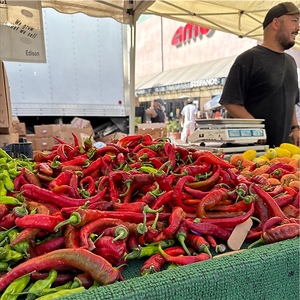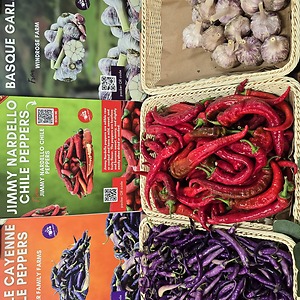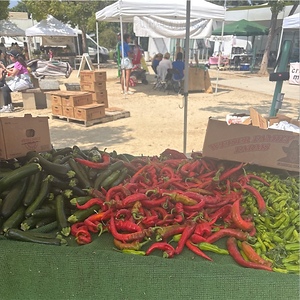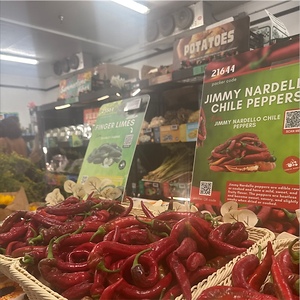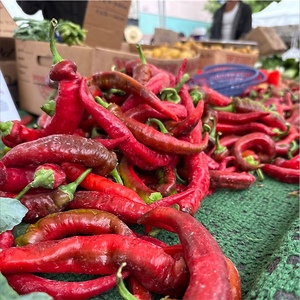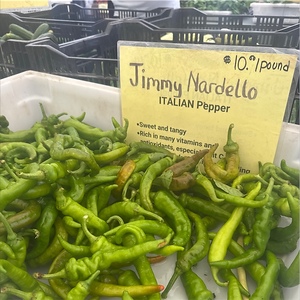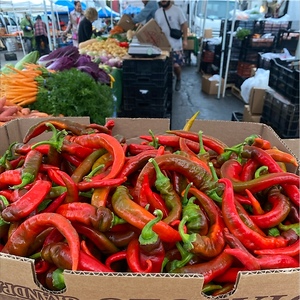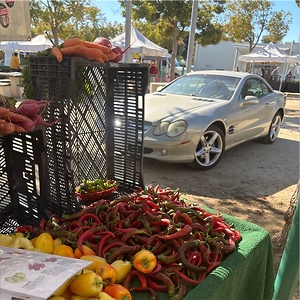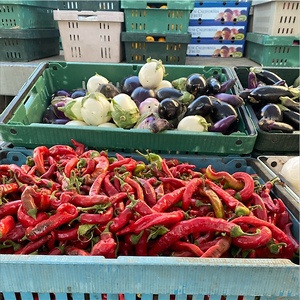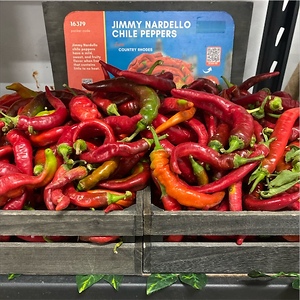


Jimmy Nardello Chile Peppers
Estimated Inventory, lb : 0
Description/Taste
Jimmy Nardello peppers are small, slender pods, averaging 12 to 25 centimeters in length and 1 to 3 centimeters in diameter, and have a conical, tapered shape ending in a blunt to pointed tip. The pods can be straight, curved, or twisted and have a rippled, slightly wrinkled nature. The variety’s thin skin is smooth, taut, waxy, and glossy, ripening from green to bright red. Underneath the surface, the pale red-orange flesh is crisp, aqueous, and succulent, encasing a narrow, hollow cavity filled with membranes and a few round and flat, cream-colored seeds. When cooked, the peppers develop a tender, soft, and buttery consistency. Jimmy Nardello peppers are edible raw or cooked and have a mild, sweet, and fruity flavor. The peppers are heatless and become sweet, savory, and slightly smoky when dried or cooked.
Seasons/Availability
Jimmy Nardello peppers are available in the late summer through fall, with a peak season in late August through early September.
Current Facts
Jimmy Nardello peppers, botanically classified as Capsicum annuum, are a sweet, heirloom variety belonging to the Solanaceae or nightshade family. The peppers were initially grown in Southern Italy and were carried by a family to the United States, where they were grown as a home garden sweet pepper. Jimmy Nardello peppers are a midseason variety that develops on bushy plants reaching 50 to 60 centimeters in height. The cultivar is primarily a homegrown plant valued among consumers for its productive nature, producing many peppers throughout the season. Jimmy Nardello peppers mature approximately 80 to 90 days after fruiting, and the variety is valued for its climate adaptability, disease resistance, and ease of cultivation. The cultivar is also known as Jimmy Nardello’s Sweet Italian Frying pepper and is favored for its sweet, candy-like flavor and versatility in culinary applications. Since its public introduction in the mid to late 20th century, Jimmy Nardello peppers have transitioned from going almost extinct to thriving as a specialty home garden pepper, a testament to specialized marketing and publicity through organizations focused on heirloom preservation.
Nutritional Value
Jimmy Nardello peppers are a source of vitamin C to boost the immune system, vitamin A to maintain healthy organ functioning, and potassium to balance fluid levels within the body. Like other sweet peppers, the variety may also provide vitamin E to protect the cells against free radical damage, magnesium to control nerve functions, fiber to regulate the digestive tract, and other nutrients, including folate, niacin, vitamin E, calcium, and iron. Jimmy Nardello peppers are a heatless variety, meaning the peppers do not contain capsaicin, the compound that triggers the brain to feel the sensation of heat or spice.
Applications
Jimmy Nardello peppers have a light, sweet, and fruity flavor suited for raw and cooked applications. The variety is often consumed out of hand as a snack and is valued for its sweet taste. Jimmy Nardello peppers are also used as a vessel for dips, minced into relishes and salsas, chopped into salads, or layered in sandwiches. In addition to fresh preparations, the Italian peppers are famously sliced and fried in olive oil with garlic, salt, and pepper. Fried peppers are served as a stand-alone dish, and the peppers are filled with goat or mozzarella cheese. Once cooked, the peppers can also be layered on crostini, pureed into sauces, mashed into spreads, topped over pizza, or mixed into pasta. Try adding Jimmy Nardello peppers to soups, stews, and chilis, grilling the peppers for a smoky flavor, or cooking with roasted meats. Beyond fresh and cooked dishes, Jimmy Nardello peppers can be pickled, canned, or dried for extended use. Dried peppers can be ground into a powder and used in paprika. Jimmy Nardello peppers pair well with aromatics such as ginger, onions, garlic, and shallots, potatoes, cherry tomatoes, herbs such as basil, parsley, thyme, and oregano, cheeses such as mozzarella, ricotta, provolone, burrata, and feta, broccoli, summer squash, green beans, and balsamic vinegar. Fresh peppers will keep up to one week when stored whole and unwashed in a paper bag in the refrigerator.
Ethnic/Cultural Info
Jimmy Nardello peppers were named after Jimmy Nardello, the fourth child of Giuseppe and Angella Nardiello, an Italian couple who immigrated from Italy to the United States and carried seeds of the pepper from their hometown. Jimmy was one of eleven children who grew up growing and eating the peppers from their family garden, but it is said that Jimmy was one of the only siblings who developed a passion for gardening. Jimmy grew the peppers in terraces, the traditional gardening method in southern Italy, and hand-strung the peppers along strands as a drying practice. He also picked the peppers when they developed a shape similar to a pig’s ear, a trick his father used to harvest the ripe peppers. In the mid to late 20th century, Jimmy donated seeds of the family variety to the Seed Savers Exchange chapter in Decorah, Iowa, forever saving the variety for future generations. It is worth noting that when Jimmy was in grade school, a teacher convinced him to drop the “I” from his surname, Nardiello, to become Nardello. Jimmy adopted the new spelling, and this name was eventually given to the peppers in honor of Jimmy.
Geography/History
Jimmy Nardello peppers are native to Ruoti, a town in the Basilicata region of Italy. Ruoti is situated in the mountains of Southern Italy, approximately one hundred miles southeast of Naples. The peppers were growing in Giuseppe and Angella Nardiello’s home garden, and in 1887, the family immigrated to the United States and settled in Naugatuck, Connecticut. Angella Nardiello carried seeds from their Italian pepper plants to the United States and planted them in her new home garden. As their family grew to include eleven children, the pepper variety was annually grown as a staple and budget-friendly culinary crop. Over time, Angella and Giuseppe’s fourth child, Jimmy, grew several of the traditional vegetables in his mother’s garden. He especially cared for the elongated frying peppers and grew them until the end of his life. Before his passing in 1983, Jimmy donated seeds of the pepper to Seed Savers Exchange or SSE, and the peppers were named in his honor. Throughout their history, Jimmy Nardello peppers have transitioned from being a homegrown plant that almost went extinct to a pepper treasured and saved by pepper enthusiasts. The variety was notably saved from extinction when they were listed on Slow Food’s Ark of Taste in 2005, a list compiled by the Slow Food organization to bring awareness to fruits and vegetables that may be facing extinction. Since appearing on the list, Jimmy Nardello peppers have grown in popularity and have become one of the favored frying peppers planted in home gardens. Today, Jimmy Nardello peppers can be found through online seed catalogs for home gardening, farmer's markets, and specialty growers in the United States and Canada.
Recipe Ideas
Recipes that include Jimmy Nardello Chile Peppers. One



